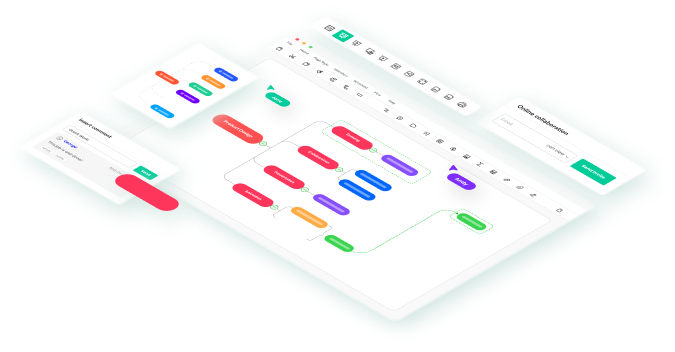
Brilliant problem-solving methodologies help the students and project managers to come up with the desired solution. Among all, one tool that focuses on systematic analysis and clarity is the fishbone diagram, also known as the cause-and-effect diagram and Ishikawa diagram.
The fishbone diagram for problem-solving distinctively resembles a fish's spine where the head is identified as the problem statement; the spine is where we put the problem into different categories, and the skeleton is where we mention the causes and the sub-causes of the given problem statement.
In this article, we will guide you on how to use a fishbone diagram for problem-solving and what generic tips you need to keep in mind when creating complex fishbone diagrams.
In this article
What is a Fishbone Diagram
As mentioned above, a Fishbone Diagram is a visual problem-solving technique invented by Japanese quality control expert Dr. Kaoru Ishikawa.
Since the diagram resembles a fish's skeleton, many project management experts started referring to the Ishikawa diagram as the Fishbone diagram. With the help of Fishbone diagrams, teams can identify the underlying causes of any problem, which facilitates systematic troubleshooting and helps avoid unnecessary bottlenecks or delays.
Importance of Fishbone Diagram in Problem Solving
Fishbone Diagrams for problem-solving serve many functions. Some of the importance of creating a fishbone diagram are:
- Team Collaboration: If a team is engaged in complex problem-solving, then creating a fishbone diagram would imbibe a sense of team collaboration, resulting in faster and optimum solutions.
- Data-Driven Analysis: Fishbone Diagramming is driven by stats, analysis, and thorough brainstorming. With the right data-driven approach, teams can easily identify bottlenecks.
- Improvement Stages: With the Fishbone diagram in problem-solving, teams have found that it leads to continuous improvement. Such business philosophy allows organizations to address different issues systematically.
Why Use Fishbone Diagrams for Problem-Solving
If you have been using other analyses like SWOT or PERT, you understand the importance of identifying the problem statement. For most such charts and analyses, the first stage is to identify the problem and the effects, and teams achieve the result by creating Ishikawa diagrams. Some important uses of the fishbone diagrams in problem-solving are:
- Identifying Problems: The first stage is to understand the problems of defining them. This sets the grounds for brainstorming.
- Categorize: When creating a fishbone diagram for problem-solving techniques, it is highly recommended to categorize the potential causes into different categories. Some common categories are People, Process, Machine, Material, and Mother Nature.
- Brainstorming: If you need to arrive at the result quicker, try having brainstorming sessions with diverse team members. Use tools like EdrawMind to analyze and discuss each cause to determine its relevance and subsequent impact on the problem.
How to Use a Fishbone Diagram for Problem Solving

To use a fishbone diagram for problem-solving methods, check out the following steps:
Understand the Problem:
The first step that you need to do is to begin by articulating the problem statement. For any problem - big or small, clarity in problem definition is very important, as it sets the ground for the entire brainstorming and subsequent analysis. The 'Effect' would serve as the head of the fishbone diagram.
Identify Categories:
While using a fishbone diagram for problem-solving, the next step you need to follow is to create the bones representing different categories of potential causes. Most experts have concluded that the most common categories are People, Process, Material, Environment, and Machines. Depending on your industry, you can make adjustments to these categories.
Brainstorm the Problem:
Invite a cross-functional team to brainstorm on different potential causes within each category. Try to encourage open discussion so you can generate as many ideas and suggestions as possible. In problem-solving, you never know which idea would trigger the solutions -- so try not to discard any idea at this stage.
Analyze Causes:
After brainstorming, start analyzing each cause within respective categories to determine the cause's relevance and impact on the discussed problem. Try to imbibe data and similar evidence to analyze the causes that support your assessments.
Root Causes:
The analysis of causes and sub-clauses will help you understand the core reasons behind any problem. Drill down with your team and ask 'Why, Where, What, When, and How?' repeatedly to help trace down the cause-and-effect relationships. By conducting this iterative process, you can easily identify the root causes, which will help you understand the fundamental reasons behind the problem.
Action Plans:
Once you and your team have used a fishbone diagram for problem-solving and have identified all the root causes, you can now shift your focus to creating an action plan to find the relevant solutions. Ensure that the action plan assigns responsibilities, sets timelines, and monitors progress to ensure successful implementations.
Tips for Using the Fishbone Diagram
Some of the most common tips for using the Fishbone diagram for problem-solving methods are:
- Begin With Brainstorming Session: Try conducting a brainstorming session before sitting down to make the fishbone diagram for problem-solving.
- Involve External Perspectives: It is often observed that external consultants can provide fresh viewpoints -- consider involving them in long-standing problems.
- Use the Right Tools: Use the right tools for brainstorming and creating fishbone diagrams for problem-solving.
- Employee Visual Elements: Enhance your fishbone diagrams for problem-solving by employing different icons and symbols. You can use icons to represent factors like time, cost, and severity - this would make it easier to prioritize the causes visually.
- Encourage Gamification: During the brainstorming sessions, try to turn the problem-solving methods into games. This can boost engagement and also help improve creativity.
Conclusion
An Ishikawa Diagram is not limited to understanding the problem statements, but with the right approach, teams can use the fishbone diagram for problem-solving methodologies. By inviting a diverse team and understanding the tips on how to use a fishbone diagram for problem-solving, teams can find solutions without wasting many resources. When you plan to do brainstorming for fishbone diagramming, use EdrawMind. The tool is equipped with built-in free fishbone diagram templates that help you easily brainstorm.




